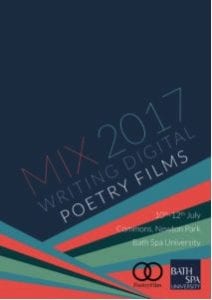by Helen Dewbery
Bath Spa University, July 2017

Revolution, Regeneration, Reflections. These were the themes chosen for the MIX 2017 conference to celebrate the human capacity for renewal and experimentation combined with deep thought and to look at where creative writing, storytelling, and media creation intersect with and/or are dependent upon technology. The programme featured a mix of academic papers, practitioner presentations, seminars, keynotes, discussions, workshops and poetry film screenings.
Artists/poets and digital writers were asked to submit poetry films/film poems/video poetry responding to these themes. Nineteen poetry films from the international submissions received were screened throughout the duration of the conference.
The selection was curated by Lucy English, Reader in Creative Writing at Bath Spa University and co-founder of Liberated Words, and Zata Banks, founder of PoetryFilm, an influential research arts project and film screening series.
I wondered if the themes of revolution, regeneration and reflections were too optimistic in theme. Perhaps war, power, consumerism, genocide, apocalypse, violence and chaos are nearer to what governs our thoughts at present.
Some of the poetry films covered predictable ground: love, word play, abstracts and introspection. Other films braved the realms of suicide, oppression, humour and sustainability. Some were cleverly and/or beautifully designed, others revealed their workings (you almost saw the filmmaker at work).
The curation itself was expertly put together. The viewer could watch to the end without feeling bombarded or overwhelmed, while at the same time feeling they had travelled; a journey which was troubling at times, more re-assuring at the end. We were taken from political marginalisation and resistance to universal sustainability in 19 films.
The first film, If We Must Die by Othneil Smith, used imagery from a 1970s Blaxploitation film to highlight resistance and a 1919 sonnet written in response to attacks on African-American communities, and began:
If we must die, let it not be like hogs
Hunted and penned in an inglorious spot,
While round us bark the mad and hungry dogs,
Making their mock at our accursed lot.
The last film, Kate Flaherty’s A Mouse’s Prayer, with a delicate voice and a mouse’s prayer to the moon, ended:
O moon, you see me
when others do not,
you know my brown fur’s sheen,
and you reflect for me
my own great smallness
in your immensely
dark and speckled sky.
At the end of the first film and the beginning of the last film, the viewer literally looked into someone’s face. This created an intimate space, connected the viewer to the personal and forged the link between responsibility and hope.
Whilst I watched, I kept thinking: this is a poet’s curation (but then, what is a poetry film if it’s not poetry?). There were no long distracting pages of seemingly endless credits, no words were trying to compete with images and there were no excessive soundtracks. Almost all the films selected had near equal elements of sound, image and text.
Selecting for a poetry film curation isn’t just about choosing the best films submitted. The films need to sit alongside one another to flow, illuminate, juxtapose — the whole should be greater than the sum of its parts.
I was able to recognize Zata’s experimental film choices that invited us to focus on semiotics. The meaning making systems in the elements that make up the films (sound, movement, etc). In Matthew Griffith’s Pain in Colour, we were asked to find meaning through colour, movement and sound but with no words.
But can you have a poem without words? I’m not sure. But I know you can have a ‘poetic experience’ and Pain in Colour offered up its own meanings within the whole curation. I’m not sure it would have done so on its own. I would prefer to see it in a gallery space, where I may be less self-conscious of finding a specific context and meaning.
The territory of poetry film is still being mapped. And as I watched the films the nagging question hanging in the mainly empty auditorium was ‘What is poetry film?’ The curation didn’t direct me to the answer. But it led me to wonder if poetry film needs to be more confident in embracing its own genres (whether that is seen as another type of art film or an entirely new genre of poetry), and then we may be nearer to developing clearer analytical language and critical discourses.
In the middle of the curation, the background evangelist in Cindy St. Onge’s Road to Damascus and the end line in Dave Bonta’s Grassland, “I’ll break like bread at your table”, gave a jolt toward the anxieties of faith and a hope for something more, and was a reminder that the curation was a journey from resistance to sustainability.
Angie Bogachenko’s version of Oracle of a Found Shoe and the collaboration between Cheryl Gross and Lucy English, Shop, both animations, demonstrated that animation works when the images and words work together, where you can’t see the seam between the two. Both showed the strength of the poem and the skill of the animator.
I noted that 11 of the 19 films, by nature of the poem or the choice of presentation, had a strong performance element. This reflects the balance of new work that I have seen emerging elsewhere. Poetry film is an ideal medium to embody spoken word poetry, and as a genre I think it will bring an immediate and urgent contribution to the field.
By design or chance, the curation at MIX 2017 brought a rhythm, line by line, film by film, that on a large scale was sustained to the end. The themes created a forward momentum — and that reflects the journey of poetry film itself.